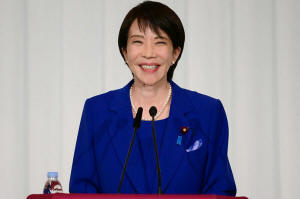Japan’s ruling party elects Sanae Takaichi as new leader, likely to
become first female PM
[October 04, 2025]
By MARI YAMAGUCHI
TOKYO (AP) — Japan’s governing party on Saturday elected former Economic
Security Minister Sanae Takaichi, a hard-line ultra-conservative and
China hawk, as its new leader, making her likely to become the country’s
first female prime minister.
In a country that ranks poorly internationally for gender equality, the
64-year-old Takaichi makes history as the first female leader of Japan's
long-governing conservative Liberal Democratic Party. Takaichi is one of
the most conservative members of the male-dominated party.
An admirer of former British Prime Minister Margaret Thatcher, Takaichi
is a protege of former Japanese Prime Minister Shinzo Abe 's
ultra-conservative vision and a regular at the Yasukuni Shrine, seen as
a symbol of Japan's wartime militarism, which could complicate Tokyo's
relations with its Asian neighbors.
Takaichi beat Agriculture Minister Shinjiro Koizumi, the son of popular
former Prime Minister Junichiro Koizumi, in a runoff in a vote by the
LDP on Saturday.
Takaichi replaces Prime Minister Shigeru Ishiba as the party hopes to
regain public support and stay in power after major election losses.
She is likely to be Japan’s next prime minister because the party
remains by far the largest in the lower house, which determines the
national leader, and because opposition groups are highly splintered.
Takaichi vows to strengthen Japan-US alliance
Takaichi later said she will immediately work on stemming rising prices,
while also focusing on diplomatic and security challenges.

A parliamentary vote is expected in mid-October. The LDP, which has been
criticized by opposition leaders for creating a prolonged political
vacuum, said Takaichi needs to hurry because the winner will soon face a
diplomatic test: a possible summit with U.S. President Donald Trump, who
could demand that Japan increase its defense spending.
A meeting is reportedly being planned for late October. Trump will
travel to the Asia-Pacific Economic Cooperation summit in South Korea
starting Oct. 31.
Takaichi said ensuring the Japan-U.S. alliance is her top diplomatic
priority.
“It is essential to ... confirm the reinforcement of the Japan-U.S.
alliance," she said. Takaichi stressed the importance of their
cooperation through three-way frameworks that also include regional
partners such as South Korea, Australia and the Philippines, pledging
Japan’s greater role in achieving a free and open Indo-Pacific.
She said she respects all tariffs and investment agreements struck
between Tokyo and Washington under the Ishiba government.
Takaichi faces major domestic challenges
The LDP, whose consecutive losses in parliamentary elections in the past
year have left it in the minority in both houses, needs its new leader
to quickly bring back voter confidence and stability and to address
challenges in and outside Japan. Takaichi will also need cooperation
from key opposition groups to implement her party's policies.

[to top of second column]
|

Sanae Takaichi, the newly-elected leader of Japan's ruling party,
the Liberal Democratic Party (LDP), attends a press conference after
the LDP presidential election in Tokyo Saturday, Oct. 4, 2025.
(Yuichi Yamazaki/Pool Photo via AP)

Ishiba, who achieved a 15% tariff deal with Washington and put
Japan's ties with South Korea and other Asian countries on track
during his one-year stint, said “I hope the LDP will band together
under new (party) president Takaichi to serve for the country and
the people, as well as the world and for the new era.”
Ishiba, a centrist known as archrival of Abe, was virtually forced
into resigning by ultra-conservative wings in the party.
There were five candidates for the job
Five candidates — two currently serving and three former ministers —
vied for the LDP presidency.
Saturday’s vote only involved 295 LDP parliamentarians and about 1
million dues-paying members. It only reflected 1% of the Japanese
public.
The LDP’s choice of Takaichi, instead of the more
centrist-to-liberal Koizumi, apparently underscores the party’s hope
to win back conservative voters who supported emerging far-right
groups such as Sanseito in the July parliamentary election.
But the LDP also needs help from the opposition, which it has long
neglected. The party will likely look to expand its current
coalition with the moderate centrist Komeito with at least one of
the key opposition parties, which are more centrist.
Takaichi shied away from her conservative and anti-China views
during campaigning
Takaichi like other candidates called herself a “moderate
conservative” during the run-up to the election to show their
willingness to work with the opposition and stayed away from
stressing her opposition to liberal social issues or anti-China
policies.
Takaichi on Saturday said the Yasukuni issue should not be a
diplomatic issue and that she will think about how she can “pay
respect to the war dead and pray for peace.”

She supports bigger fiscal spending for growth, a stronger military
and cybersecurity, as well as tougher regulations on increasing
foreign tourists and laborers. She was criticized for citing
unconfirmed reports to slam foreigners for kicking deer in Nara, her
hometown, and saying many foreign law offenders escaped indictments
due to a shortage of translators.
Experts say candidates avoided discussing their usual political
views on historical issues, same-sex marriage and other contentious
topics, including the party’s political funds scandal, which was the
biggest reason for their election losses, and anti-corruption
measures. Their avoidance of these subjects raised doubts over the
party's ability to regain public trust, analysts said.
All contents © copyright 2025 Associated Press. All rights reserved |